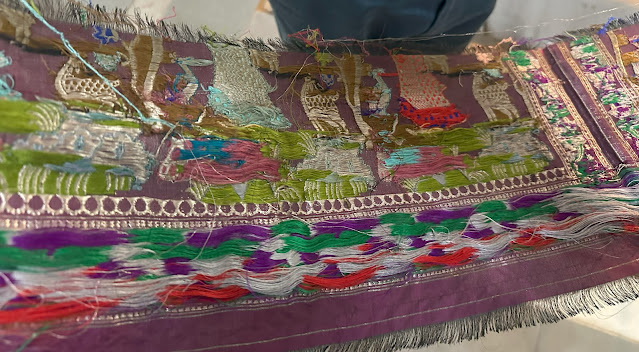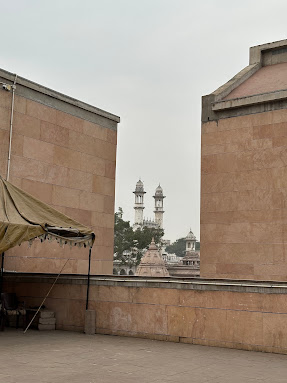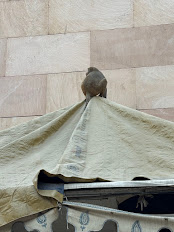December 25, 2024
India is famous for its textiles, particularly its silk, and Varanasi is known as one of the chief and best producers of silk in India. If we had known that, we may have purchased fewer woven items from the looms in Kaziranga/Assam! (Okay, maybe not.)
With our permission, our guide took us to one of the weaving ateliers in Varanasi. It was located in what looked like a large, beautiful home.
We walked into a large room full of a dozen or more looms, some in use and some not.
Creating these masterpieces by hand is a tradition that dates back about 500 years when silk became synonymous with wealth and every woman had to have a silk sari or two (or fifty).
Although hand weaving is in steep decline due to power looms, some textile enterprises, like the one we visited, still hold fast to the traditional weaving ways.
Sharp-eyed weavers must be able to follow the code on the scrolling card as they weave their shuttle through the longitudinal warp threads. Only the finest silk threads are used at places like this.
And who wouldn't love this graffiti? It's certainly not Banksy's work! That's Ravana on the left, the 10-headed devotee of Shiva. On the right (I think) is Shiva himself, god of destruction but also of transformation and regeneration.
Our itinerary had the option of visiting the Kashi Vishwanath Temple, more popularly known as the Golden Temple. However, we were running out of time and there was something about whether or not we would be allowed inside. So our guide decided to take us to a good viewpoint instead. I'll just say that it wasn't quite the same as being there.
All of these colors are being used in one weaving. Look closely and you can seft the threads reaching up from the spools and into the warp threads.
I had already purchased two woven pieces in Kaziranga, but it was hard to resist this far superior quality. (Bob, didn't I tell you not to let me buy any fabrics? You failed in your responsibiility.) Chris and I both bought table runners, and I bought an additional cloth that I thought I might be able to hang on the wall. (It turned out to be just a little too large for the spot I had in mind.)
After lunch, we headed back into the bustling city streets of Varanasi. I never got used to the loaded carts or to the doors that looked like portals to another, calmer world. (Anything would be calmer than the street).
There are endless things to see in Varanasi streets, from the ordinary (like this lady feeding two stray dogs a bowl of milk) to the extraordinary (an ornate temple that is dedicated to the nine planets but is tightly squeezed between two buildings):
Our itinerary had the option of visiting the Kashi Vishwanath Temple, more popularly known as the Golden Temple. However, we were running out of time and there was something about whether or not we would be allowed inside. So our guide decided to take us to a good viewpoint instead. I'll just say that it wasn't quite the same as being there.
About 2,200 pounds of gold donated by Ranjit Singh (1780-1839), the founder and first maharaja/king of the Sikh Empire in northwest India, was used to plate the main dome and creat three smaller domes made of pure gold. This temple is considered to be one of the most important of all Hindu temples because it is believed that it was here that the first (out of twelve times) jyotirlinga, or Shiva appearing as a fiery pillar of light, shot upward through the Earth's crust towards the heavens.
We could also see the Gyanvapi Mosque, constructed circa 1678 AD on what some believe was the site of a Shiva Hindu temple that was destroyed on the site ten years before.
We had a good view from that spot, but a monkey wanted a better view, so it climbed up a pipe to the roof.
. . . the cremations.
We joined a larger, motorized boat carrying ten or twelve passengers for this excursion. It would be hard to row a small boat among the many large ones on the river, and we also had a better view from the larger boat. It seems really creepy that so many people are there to gawk at the ritualistic burning of human bodies, and yet there we were, hull to hull and gawking with everyone else.
There is an interesting short story by Rudyard Kipling called "The Bridge Builders" that is about this very bridge, although in the story the bridge is called the Kashi Bridge. It begins with a detailed description of how the bridge was built, and then describes a massive flood that threatens the entire structure on the eve of its completion. The chief engineer of the bridge, high on opium, has a vision of the Hindu gods protesting the bridge and challenging the colonial power. Nevertheless, the bridge survives the flood.
It was time to head to the Ganges for our evening boat ride, so we headed down from our lofty viewpoint, passing this door on the way. I don't know if you can tell, but I'm obsessed with doors.
Both the river and the shore were filled with the usual cacophony that is India.
Dozens of boats of various sizes were lined up, waiting for customers for the big show of the night . . .
We joined a larger, motorized boat carrying ten or twelve passengers for this excursion. It would be hard to row a small boat among the many large ones on the river, and we also had a better view from the larger boat. It seems really creepy that so many people are there to gawk at the ritualistic burning of human bodies, and yet there we were, hull to hull and gawking with everyone else.
Some of the infernos were attended only by those stoking the flames, but others had large groups of what I assume were family and friends. If you believe this act liberates your loved one from the endless cycle of birth, death, and rebirth and sends their soul to a state of permanent bliss, then this is a joyful event.
We putt-putted under the Malviya Bridge, a double-decker span with a train on the lower level and vehicles on the upper level that was the first of its kind built in India. The 3440-foot-long bridge was completed in 1887.
There is an interesting short story by Rudyard Kipling called "The Bridge Builders" that is about this very bridge, although in the story the bridge is called the Kashi Bridge. It begins with a detailed description of how the bridge was built, and then describes a massive flood that threatens the entire structure on the eve of its completion. The chief engineer of the bridge, high on opium, has a vision of the Hindu gods protesting the bridge and challenging the colonial power. Nevertheless, the bridge survives the flood.
Somewhere near the bridge we stopped to watch the Ganga Aarti ceremony, a traditional Hindu ritual performed daily at dusk as a symbolic tribute to the sacred Ganges River. It involves twangy music, intricate choreography, lots of incense, and colorful costumes.
We disembarked at the Namo Ghat where a 25-foot-tall sculpture of praying hands in the namaste position welcomes travelers.





































(Bob) This evening of cremation watching was my favorite thing in India, except for the animal safaris in Kaziranga. I found the cremations very moving and enjoyed just sitting on the boat watching and thinking about it, the impact on the family watching, as well as the industry built around it. Varanasi was also my favorite place for crafts, beautiful crafts, some of which you still need to post about.
ReplyDelete